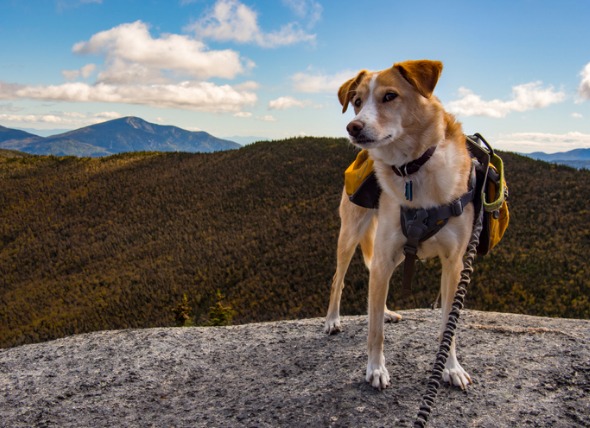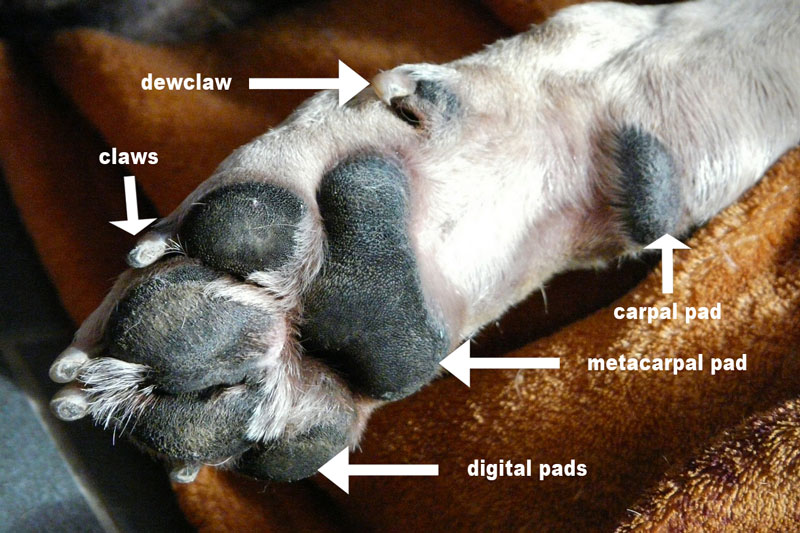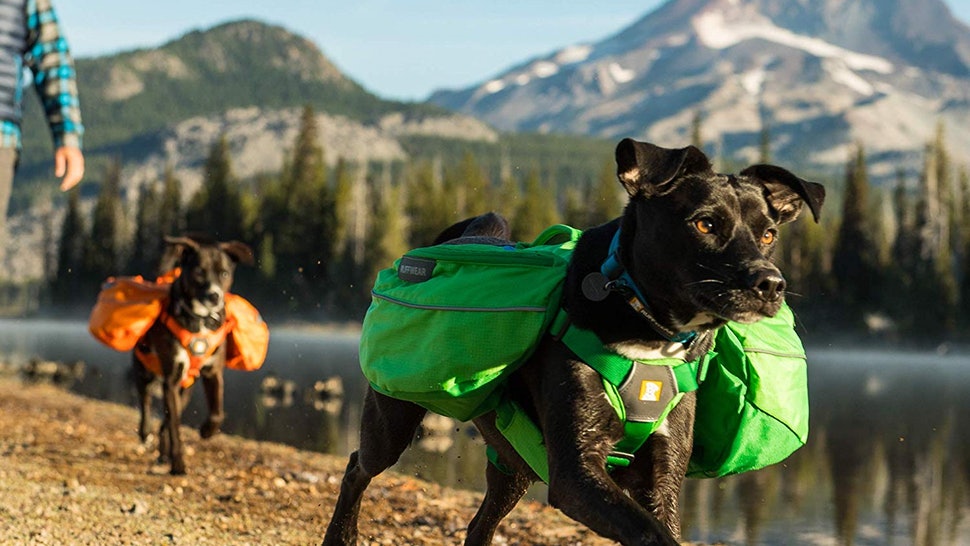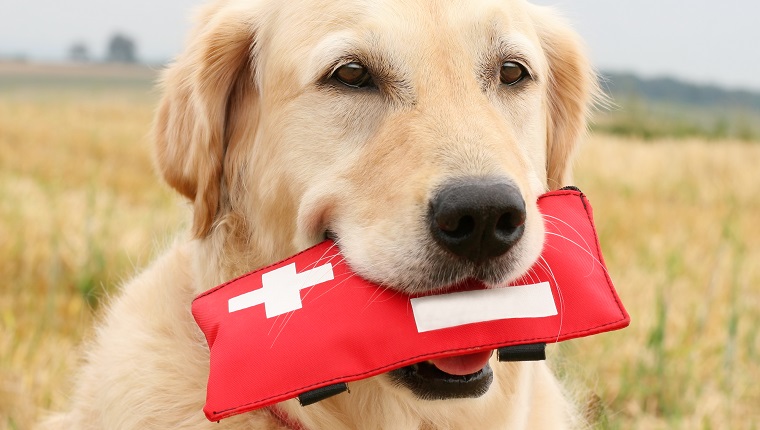Hiking is an adventure that involves a considerable amount of adventure, adrenaline, and risk. It takes more effort than what you may assume by just looking someone’s Instagram photo with their dog walking through the Rockies.
When you’re taking your pet with you on a day-long hiking activity, you must assure that every safety measure is in place. You wouldn’t want to risk your dog’s life!
Hiking with a dog
Hiking with dog is one of the most undertaken outdoor activities. It can also be taken as a short trek that ends within a day. Walking through the prairie, going up in the Rockies, or trailing through the national park are few of most sought hiking with dogs.

Not every dog is adapted to walking long distances. The distance they could cover in a day may depend on their breed, activity level, and lifestyle. Here are four major factors that determine their overall hiking ability.
i. Age
Active hiking dogs are experienced in hiking long distances on a regular basis. They can hike 15 to 20 miles per day, whereas, the dogs that aren’t used to long hikes can walk up to 10 miles per day.
Young pups and older dogs aren’t eligible for long hiking. Most vets recommend that you limit their daily walk to about two minutes per week of age. The bones of a young pup are not yet fully developed to take strenuous walking session. Older dogs, on the other hand, have weak joints and hip issues that make them unable to take a long walk.
ii. Breed
Some dog breeds are better suited for long walks. A small dog with short legs aren’t used to walking long distances like most large breeds. Labrador Retrievers and Border Collies are well suited for hiking. The Bernese mountain dog, Siberian husky, and Alaskan malamute are also used to long hiking, especially in the rocky or snowy terrain.
iii. Activity level
Activity level is determined by how much time does your dog spend inside the house or outside playing. You can’t expect your dog to suddenly enjoy long hikes when they are only used to lunging at the comfort of the home.
iv. Overall health
The overall health, fitness, and endurance determine the dog’s ability to go for a long hike. Health issues can slow them down.
Q&A How old does your puppy need to be to go hiking?
The appropriate age for a dog to go on hiking depends on many factors, such as breed, size, and overall health. Young pups are prone to growth plate injuries when they over-exercise. Dogs are vulnerable until they reach the age where they stop growing physically.
How to Train your Dog for Hiking?
A dog wouldn’t start enjoying long hikes suddenly or get up for a long walk through difficult terrain. Although this can be a healthy and fun experience, you would need to train your dog for the hiking. Here is a list of tips to help you get started.
a. Start slow
Don’t rush the idea of training your dog for hiking. Take time to train it and start with basics! Start with shorter 2 to 5-mile hikes at first. You can do this by walking your dog to the park, forest, and other easy terrains.
b. Increase time gradually
Gradually increase the time or distance your dog covers in a day. Timing the walks every day helps to estimate the progress.
c. Take regular breaks
You can consider taking a break every 20 minutes of walking. Taking a break helps to catch a breath and control heart rate.
d. Dog’s energy level
Notice your dog’s energy level during the walk. The energy level keeps spiking up every day, hence you can walk more each day.
e. Vary the terrain
As a starter, you can walk on flat terrain such as parks. You can start introducing varying terrain as you progress. Take your dog over hills and uneven ground. You can choose difficult terrain when your dog becomes used to walking long distances.
Find the complete dog training list.
Q&A How to prepare a Dog’s Paw for Hiking?
The dog’s paws are naturally tougher and are made up of fat, connective tissue, and very thick skin. However, they are not totally impervious to being injured on a hike. A dog's paws can get blisters, cuts, or burns during a tough walk.

You can prevent this by following these preventive tips.
- Use dog boots for difficult terrains
- High-Quality paw wax can help protect paws and also promote healing of cracked and damaged paws.
- Toughen their paws by taking them out more
- Only hike when it’s cool
- Keep their nails trimmed
- Moisturize their paws
Trail Etiquette when hiking with dogs
The dog’s bad etiquette when hiking increases the likelihood of dog restrictions from the trail. More than dogs, the problem lies in the uninformed dog owners. Here are five simple rules to help your dog showcase its best manners.
a. Choose a Dog-Friendly Trail
Before embarking on a hike, check if the trail is dog-friendly. Most trails kept dog restrictions in the past because of unruly dog and their owners. Research the best places to take your dog hiking, and go online or call the ranger station associated with your hiking destination to find out if dogs are allowed on the trails. Most national parks around the country keep dogs and other pets out except in designated areas. Many national and community forests allow pets. Check with the respective authority before heading out.
b. Abide by ‘The Leash Law’
Most designated area put the leash law and you’re required to abide by the law. Your dog must demonstrate excellent leash skills and exceptional recall. Choose the right kind of dog leash, few trails require a non-retractable lead, six or fewer feet in length.
- A trail-worthy dog should be able to hike easily with a loose lead.
- A trail-worthy dog should be able to hike at a true heel, at or slightly behind your knee.
- A leash-yanking dog is not a trail-worthy dog: train it at home before your hike.
- If your dog will hike off-leash (assuming it’s sanctioned), it should always stay within sight and within earshot of you, and demonstrate excellent voice recalls such as following the commands i.e. No! Sit! Stay! Come! Off! Or Leave it!
If you anticipate heavy traffic on the trail, keep your dog leashed. This will prevent any unwanted confrontation with other animals or humans.
c. Clear Trail for Other Hikers
When you’re sitting idle or waiting for someone, you should get your dog out of the way when other hikers approach the trail. This helps to prevent your dog from chasing other hikers. You should also leash them when other hikers, cyclists, or animals approach. Simply put, this means get your dog out of the way—beyond the “sniffing” range—of other hikers, horses, and cyclists.
Many dogs enjoy giving chase to passerby, even obedient dogs, hence, you must reel it in and leash it when you see cyclists or animals coming.
d. Reduce Environmental Impact
When hiking, leave the surrounding plants and wildlife undisturbed. You should keep your dog stick to the trail to minimize the environmental impact caused by a restless animal. If your final destination lies off-trail, make the most direct path to it in a line that is perpendicular to the trail. When you’re hiking above the tree line, walk on a rock as much as possible.
Keep your dog away from disturbing the local wildlife. It’s common for a dog to chase small animals such as rodents, butterfly, and birds. Letting your dog to bark at wildlife can provoke an attack.
The best rule of thumb: leave all plant and animal life exactly as you found it for others behind you to enjoy.
e. Leave No Trace
Leave No Trace policy basically means to reduce human waste from natural destinations. It helps to protect the local biodiversity by keeping the trail clean. You should always carry a trash bag to carry dog poops. If you do not have a trash bag, you should bury pet waste in a 6 to an 8-inch hole that’s at least 200 feet away from trails, camps, and water sources.
The pollutants left by humans generally end up at water sources or degrade the setting. You can prevent this by taking reasonable measures.

Common Dangers and Threats
Some of the common dangers and form of threats faced by dogs and their companions in hiking are as follows;
a. Bikes and Horses
It’s common for hiking trails to receive cyclists. You cannot wait for a cyclist to notice your dog on the trail, hence it’s recommended to keep your pet by your side or leash it immediately when you notice a cyclist coming.
Many dogs, even obedient dogs, have a tendency to chase the cyclists. It’s always better to keep them on a leash when you approach the cyclist. Likewise, if the trail contains horses, you should be wary of their presence. An unsuspected dog may spook the horse that can lead to fatal accidents.
b. Dehydration
It’s common for animals to easily get dehydrated on hiking due to sun or heat. The momentary pauses are required at every interval to get rehydrated and catch a breath. Skipping the water bowl puts them at risk for dehydration, which can be life-threatening. You should offer them water even though they don’t seem thirsty. Slowing down during the hike is one of the major signs of dehydration.
c. Too much Sun
Dehydration, heatstroke, and sunburns can be fatal during hiking. If you’re too much exposure to the sun, it’s likely to get dehydrated or heat stroke. It is advised only to walk when it’s cool. You can avoid hiking trails that are too hot or provides fewer shades. Ask your veterinarian which sunscreen they would recommend for your dog. Excessive panting and difficulty in breathing are signs of dehydration and heatstroke.
d. Contaminated Water
The important thing to remember in the hike is to avoid drinking from local pond, creeks, rivers, or lakes. Freshwater River and lakes can be a safe source for drinking water, however, you should avoid any still water sources. Contaminated water can be home to diarrhea-inducing parasites, from common Giardia to the more dangerous Leptospirosis, which can cause kidney and liver damage.
The best thing to do is to carry your own water.
e. Open Water
Open water sources around hiking trails can be fearful. It can cause drowning. Lakes and rivers require a higher level of swimming proficiency than the backyard pool.
Waterfalls and hot springs are most sought after hiking destinations, but dog owners don’t always realize how dangerous they can be. Many canine companions have tragically died after going over waterfalls, and in some cases, people have plunged to their deaths while trying to save their pets.
f. Wildlife
The local wildlife poses as big a threat as water, and hiking through areas infested by dangerous animals can be life-threating to both you and your pet. You should review the hiking trails before visiting and ascertain what sort of animals are found entrail. Most national parks may contain wild animals.
To bears and other predators–including mountain lions and coyotes–your beloved pet is just prey. So it’s best to avoid taking dogs into their habitats.
Doggy First Aid Kit
Emergencies can strike at any time! Although you can’t procrastinate that your dog will encounter troubles in hiking, you must be prepared to tackle any emergency.
Carrying a first aid kit during hiking is essential. You can buy a first aid kit or make one yourself. Some of the key tools to carry in your first aid bag are as follows;
Paperwork
Keep a hard copy of your dog’s medical records, vaccination records, any prescriptions, and emergency phone numbers, so you can access it anytime you want.
A canine first aid manual published by the Red Cross suggests “Do you really know, off the top of your head, how to give CPR to dogs?” Whatever you may think, this is one of the key first aid essentials.
Gauze, non-stick bandages, and adhesive tape
To control bleeding and protect wounds, you should have gauze as a makeshift muzzle, non-stick bandages so it doesn’t peel off their fur and adhesive tape. You can control their bleeding until you reach the nearest clinic.

Extra Food
Be sure to pack even more of your dog’s food than you’ll think you’ll need. You would never know what may befall in the hiking. Packing extra food ensures that you will be able to stay full of energy, even if the hike extends for a few more hours.
Hydrogen peroxide
Hydrogen peroxide is used to induce vomiting if your dog eats something toxic. Be familiar with the proper dosage and way to it administer before you need it and check with either poison control or a veterinarian before use. Your dog can accidentally ingest poisonous plants or materials along the trail. This can be prevented by the use of hydrogen peroxide.
Antibiotic spray or ointment
This will help prevent any fatal infection from scratches and cuts. You can use some antibiotic wipes, as well, for cleaning wounds, and styptic in liquid or powder form to control bleeding.
Milk of Magnesia, or activated charcoal
Milk of Magnesia or activated charcoal can be used to absorb poison, but always check with your veterinarian first.
Treats
You can choose to carry treats for any unexpected duration such as emotional support when your dog is injured or playtimes.
An eyedropper or syringe
You can use this to flush wounds or to give oral medications.
An extra leash and collar
Things can get lost when you travel, and in an accident or other emergency situation, his collar may come off or the leash may snap.
Dog food
Your dog will need extra calories than they normally eat when they are hiking. Dogs will need about 25% more calories than they normally eat to keep their energy up on a hike.
You can mix a high-calorie puppy food into your dog's normal food that adds extra calories even in a small amount of food. You can do the exact calorie math or just estimate by replacing 25% of your dog food supply for the trip with the puppy food.
You can also feed your dog freeze-dried food on the trail. Freeze-dried food is more expensive than kibble but it can be worth it. It is often half the weight of kibble.
Dog Backpack for Hiking
You can prepare a hiking backpack for your dog by yourself. It should contain items that remain essential during hiking. The requirement of certain gear may depend on the trail and the duration of the hike.
The list of things required for a Dog’s backpack are as follows;
- Multi-functional hiking pack
- Food and water utensils
- Water bottle
- Dog tracking gear
- GPS Tracker
- LED collar cover
- Collar light
- Reflective vest
- Security
- Protective Gear
- Jacket
- Dog Shoes
- Towel
- Paw wax
- Life jacket
- Sleeping gear
- Health and cleanliness
- Cooling jacket
- Tick remover
- First Aid
In case of emergency contact pet medical service that offers on-site medical attention and evacuation. Contact through phone for fast first aid.